|
Posted in category "Lesbians & Gays"
Ed Murphy told me: “J. Edgar Hoover is one of my sisters.”
In 1983, I was shocked to hear Ed insinuate that the late FBI director was gay and liked to dress in women’s clothes. Even among very gossipy gay men, I never heard a breath of rumor that the late FBI director liked guys and was also a transvestite. Similarly, in the 1980s at Dignity/NY, I learned that the ruthless society lawyer, Roy Cohn, had contracted AIDS, not cancer of the liver as he claimed. Ed may have known about Hoover from firsthand stories he heard, and likely had pictures to prove it. I’m not clear if Ed Murphy’s claims are from the time of the “Chickens and the Bulls” blackmail period, or, whether the Mafia had compromising photos of Hoover and his associate director and companion, Clyde Tollson, from years before.
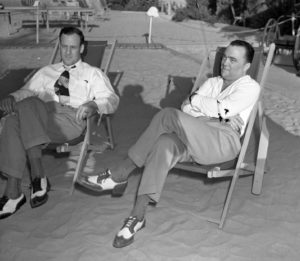 Clyde Tollson and J. Edgar Hoover on vacation In his explosive 1993 book, “Official and Confidential: The Secret Life of J. Edgar Hoover,” author Anthony Summers claimed Hoover denied the existence of the Mafia and never pursued them because the Mafia had blackmail material on him. One of the photos was said to show Hoover blowing Clyde Tollson. The knowledge of Hoover’s homosexual activities may have kept gangsters like Meyer Lansky and Frank Costello safe from FBI scrutiny.
Author David Carter wrote in his 2004 book, “Stonewall: The Riots That Sparked the Gay Revolution,” that when FBI agents joined the “Chickens and the Bulls” case, they found a photograph of J. Edgar Hoover “posing amiably” with one of the ringleaders and discovered information that Clyde Tollson was being blackmailed by the extortion ring. Both the photograph and documents disappeared after the FBI joined the investigation. David Carter thought Ed Murphy was the man posing with Hoover. Journalist and author Burton Hersh said that it was Sherman Kaminsky. It may be that Ed Murphy’s decades of work in Mafia-run gay bars, and his involvement in male prostitution and blackmail gave him access to knowledge and photos, which not only kept him safe from the Feds, but out of jail in the “Chickens and the Bulls” case.
Elwood Hammock, one of the chief extorters in the “Chickens and the Bulls” case also said that J. Edgar Hoover was homosexual as detailed in a memo dated May 19, 1966, from Special Agent in Charge (SAC) in Charlotte, N.C. to Director, FBI. The memo describes a taped telephone interview with an unnamed woman the evening of May 18, 1966. It was conducted by FBI agent Charles S. Miller of Durham, N.C.
“(BLANK) stated that on or about 4-10-66 (BLANK) ELWOOD HAMMOCK (BLANK) New York City. She recalled that ELWOOD was intoxicated at the time, and he was discussing various personalities in whom he and his confederates were interested. During the course of this conversation, he stated to her that J. EDGAR HOOVER was a homosexual. He stated also that he, ELWOOD HAMMOCK, and (BLANK) who she later learned was (BLANK) allegedly had telescopic movies or photos of a blond, blue-eyed young man who resided in either Georgetown or Bethesda, Maryland. It was not clear to (BLANK), but she gathered that this young man was guarded by two Doberman pinscher dogs, and she gathered by inference that this young man was an alleged friend of MR. HOOVER. She stated she was shocked when ELWOOD made such a fantastic allegation, and she informed him that it was utterly impossible and untrue. She stated that (BLANK) was an inveterate liar, and she placed no substance in his statement. She stated she admired the Director greatly, recognized what he had done for the country, and as she thought about the matter more, she decided to repeat ELWOOD’S conversation to a Detective (BLANK) of the New York District Attorney’s staff with whom she had been working.”
The person who had the most damaging information about J. Edgar Hoover was Susan Kaufman Rosenstiel, the 4th wife of liquor magnate Lewis S. Rosenstiel, chairman of Schenley Industries, Inc. Rosenstiel, a bisexual, was a former bootlegger who was a close associate of mobsters Meyer Lansky and Frank Costello. He was good friends with power broker attorney, Roy Cohn, and J. Edgar Hoover. He endowed the J. Edgar Hoover Foundation with $1 million in 1965. Lewis Rosenstiel’s lifelong involvement with mobsters came to light only in 1970, when the New York State Legislative Committee on Crime determined that he was part of a consortium to smuggle liquor during Prohibition.
Lewis and Susan Rosenstiel had an ugly, contentious divorce before Lewis Rosenstiel moved on to Wife #5. Rosenstiel spent almost half a million dollars trying to concoct evidence to use against his wife in divorce proceedings. He may have turned to his friend, J. Edgar Hoover, for help. At least, this is what Susan Kaufman thought, believing that the FBI director helped stack the cards against her in divorce court. In retaliation, she told anyone who would listen that Hoover was a cross-dresser and homosexual.
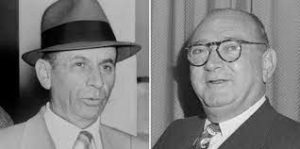 Meyer Lansky & Lewis Rosenstiel During their divorce, Rosenstiel’s 4th wife, Susan Kaufman, alleged that Rosenstiel hosted orgies at the Plaza hotel where he supplied “boy prostitutes” for certain guests. Kaufman would later make the same claims under oath for the New York State Joint Legislative Committee on Crime in the early 1970s. Most of Kaufman’s testimony to the Committee was behind closed doors and remains sealed. Her claims are shocking, but both the Crime Committee Chairman, John Hughes, and his Chief Counsel, Edward McLaughlin, found them credible. McLaughlin remembered her as an excellent witness: “I thought she was absolutely truthful. The woman’s power of recall was phenomenal. Everything she said was checked and double-checked, and everything that was checkable turned out to be true.”
 Roy Cohn on vacation Larry Summer’s book, Official and Confidential: The Secret Life of J. Edgar Hoover,” describes one night in 1958 where Susa n Rosenstiel witnessed a sex scene with her husband, Roy Cohn, J. Edgar Hoover and two teenage boys in a suite at the Plaza Hotel in New York. Hoover was in drag, “wearing a fluffy black dress…lace stockings and high heels, and a black curly wig. He had makeup on, and false eyelashes. Roy introduced him as “Mary” …It was obvious he wasn’t a woman; you could see where he shaved.” They had some drinks, and the teenage prostitutes arrived. They went into the bedroom and “Mary” undressed, taking off his dress and pants and leaving on a garter belt. He lay on the bed, “and the boys work on him with their hands. One of them wore rubber gloves…Then Rosenstiel got into the act with the boys. I thought, “You disgusting old man.” Hoover and Cohn were watching, enjoying it.”
If what she described happened, it would be easy to imagine that Meyer Lansky and others in organized crime had blackmail photos of Hoover in a dress or getting serviced. Susan Rosenstiel quoted her husband as saying, “because of Lansky and those people, we can always get Hoover to help us.” Hoover was a blackmailer himself. “He was the biggest fuckin’ extortionist in the country,”
Ed Murphy told Arthur Bell in a 1978 interview. “He had presidents by the balls. He had a record on everybody and his brother.”Not everybody believed Susan Kaufman’s stories. Robert M. Morgenthau, the U.S. Attorney in New York, found her claims baseless. So did famous attorney William Hundley, at that time working in the U.S. Justice Department. “Susie Rosenstiel had a total axe to grind,” Hundley said. “Somebody who worked for me talked to her. It was made up out of whole cloth. She hated Hoover for some alleged wrong he had done. Plus the story was beyond belief.”
The story does sound fantastical. How could the head of the FBI–and a notorious blackmailer himself–get himself into a position where he was held hostage? Perhaps it was a trade-off. Hoover had his secrets protected and access to male prostitutes. In return, organized crime didn’t need to worry about the FBI nosing too deeply into their operations.
Coming Tomorrow: Chapter 5: Stonewall Shakedowns
The blackmail scheme of “The Chickens and the Bulls” as the New York City Police Department called it, or “Operation Homex” to the FBI, is now unknown or forgotten by most lesbian and gay people and activists. The name refers to an extortion ring of cops and criminals that preyed on prominent, closeted gay men in the 1960s. Corrupt police officials and police impersonators known as “Bulls” used young male prostitutes called “Chickens” to blackmail wealthy, important, or closeted pillars of the establishment across the country. The ring victimized thousands of men, including politicians and government officials, military officers, film, TV and entertainment celebrities and producers, prep school and university professors, headmasters, and trustees, surgeons, scientists, business executives, and Catholic priests. Most of the “chickens” were teenage runaways from homophobic or abusive family backgrounds. They survived by turning tricks in the back of trucks parked on waterfront piers, seedy hotels, or getting pimped out to strangers.
This is how the scam worked: a man would travel to a large city, like New York or Chicago, where he would procure the services of a male prostitute. The prostitute would be solicited at a gay bar, in the bar of a hotel, or in the hotel’s men’s room. Sometimes the Concierge of the hotel was involved. Once the blackmail victim and his prostitute were alone in a hotel room, one of two things would happen; the prostitute would steal the man’s wallet and run out of the hotel, or the “Hotel Detective” would burst into the room and demand cash for not arresting the visiting victim. The stolen wallet would be turned over to the ringleaders, who with their corrupt law enforcement associates, would compile information on the victim. If the “John” was rich, famous or from a prominent family, two members of “law enforcement” would travel to the man’s home or place of business and threaten him with public exposure – even arrest – unless they were given cash to make the case disappear. The men paid rather than have their homosexuality disclosed. One such encounter, heavily redacted, was described in an FBI memo:
“(BLANK) is a guitar player with (BLANK) and while in New York City in 1965 picked up and committed oral copulation on (BLANK) at the Hilton Hotel, 34th Street. Upon (BLANK) return to California, he was approached by an individual named (BLANK)…who posing as a New York City police officers, extorted an unknown sum of money from him. The extortion again was a result of threatened public exposure and/or incarceration for a New York City homosexual act.”
As the NYPD and the FBI pursued their investigations in 1965 and 1966, they found that the blackmail ring operated in large cities around the country and had a fluid cast of about two dozen chickens and bulls. One of them was Edward Murphy, who was the house detective for the Hilton Hotel on 34th Street in New York. “DETECTIVE AT HOTEL IS HELD IN EXTORTION” the August 5, 1965, New York Times headline blared.
“A 39-year-old house detective at the New York Hilton was arrested early yesterday as the leader of a gang that had extorted a total of $100,000 from “rich playboys and executives…The house detective, Edward Murphy, was held in $7,500 bail for a hearing August 13. He was charged with extortion and impersonating an officer.”
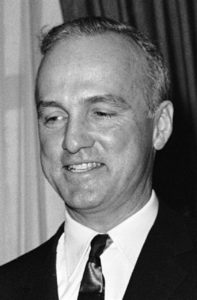 Rep. Peter Frelinghuysen, 1960s Among the men that Ed Murphy identified as victims of the blackmailers were Congressman Peter Frelinghuysen (R-NJ) and Admiral William Church, cousin of the powerful senator Frank Church (D-ID), and head of the New York Naval Yards in Brooklyn. An FBI memo described the night Rep. Frelinghuysen picked up a chicken:
“(BLANK) stated the Congressman was very scared and he told (BLANK) that he was a doctor and that his wife and kids were out of town. The Congressman invited (BLANK) to his house to have a drink. (BLANK) went with the Congressman and after arriving at the house, the Congressman told (BLANK) to take off his clothes and make himself comfortable. (BLANK) undressed and the Congressman undressed. Both had a couple of drinks and the Congressman then committed two perverted sexual acts upon (BLANK).”
Ultimately, Rep. Peter Frelinghuysen paid $50,000 in blackmail money. When Admiral Church was approached by NYPD James McDonnell to testify before a grand jury, he was initially “arrogant and abrupt.” Church told McDonnell that he wouldn’t accompany him back to New York, but he would drive up the next day. Instead, he drove to a motel in Maryland and committed suicide. Admiral Church’s shakedowns had started several months after being robbed of his wallet by a chicken at the Astor Hotel in New York. He had handed over $5,000 to the blackmailers before he put a bullet in his head. Most of the victims were wealthy enough to pay off the blackmailers. In a New York Times article published on March 3, 1966 – “Nationwide Ring Preying on Prominent Deviates,” a celebrity believed to be Liberace is described.
“A TV celebrity, a twinkling star who has millions of female fans all over the world, refused to take the witness stand. However, he did tell investigators that he had paid blackmailers more than $20,000. “I can afford to lose the money,” he said, adding: “I hope they die of cancer.”
The case of the “Chickens and Bulls” began with an arrest of a man impersonating a detective at Grand Central Station in New York. 34-year-old John Aitken was the bogus detective. The arresting officer was NYPD detective James McDonnell. During his interrogation back at the 17th precinct, Aitken said that, in exchange for a light criminal charge, he would reveal details about an extortion ring that had shaken down dozens of prominent closeted homosexuals, most of them married with families. He talked for hours, and McDonnell was amazed at the names he revealed and the money the ring had collected. Aitken’s tips led to the arrest of Ed Murphy by Detective McDonnell at the Hilton Hotel. According to McDonnell, Murphy had been arrested with a counterfeit detective’s shield in his possession. Some of the cops at the station house were ready to take Ed into a back room and give him a beating for passing himself off as one of them. But McDonnell intervened to protect Murphy and recruited him as an informer. “I told Murphy I’d be straight with him and he trusted me.”
The leader of the blackmail ring was 51-year-old Chicago Police detective John J. Pyne. Pyne joined the Chicago Police Department on September 24, 1938, and served until June 24, 1966, when he was arrested by the FBI. The agents found a drawer filled with police badges and identification from almost every state in the country, together with arrest forms and extradition warrants in Pyne’s Chicago home. They also seized an Olympia typewriter from Pyne’s residence whose keys matched various typewritten documents and warrants. He was charged with conspiring to use interstate transportation and the mails to extort money from gay men. According to FBI memos, Pyne was the “big man” who received 10% of all extortion money.
“PYNE is described as a white male American in his 50s, 5’11” and of medium weight, grey hair, of Irish descent, distinguished looking, who drives a 1966 bronze Bonneville and who lived close to O’Hare Field Airport in Chicago, Illinois,” the FBI memo stated. “PYNE is further described as the nephew of former Mayor Kelly of Chicago and as (BLANK) utilized by the gang. PYNE is reverently referred to by gang members as “JAY P.”
Pyne was responsible for seeing that all gang members get out on bond if arrested, securing the services of an attorney for them, furnishing them with authentic and fraudulent police identification credentials and/or warrants. He used his contacts within police departments around the country to get badges and documents that his gang could use in extortion attempts. Pyne was ruthless. According to the FBI memo, when Pyne learned that one or two of his extortionists had had sex with their victims, he contemplated killing those accomplices to keep them quiet.
Sherman Chadwick Kaminsky, 38, Elwood Lee Hammock, 48, and George Michael Gentile, were Pyne’s chief extortionists. Once they were caught, they revealed the full scope of the operation and helped the FBI nail Pyne. Kaminsky went under the alias of Paul Vargo and had “salesman” listed as his occupation. Kaminsky said he was “born and raised on the streets of New York.”
 Sherman Chadwick Kaminksky, 1966 His working partner was 27-year-old John Fellenbaum, a six-foot bodybuilder whose beefcake physique was an attractive lure. In most instances, Fellenbaum beat the victim and stole his wallet or billfold. During his trial, Fellenbaum made a gentlemanly antiques dealer from Maine take the stand and publicly “out” himself, only to plead guilty immediately after the opening trial session. This angered the judge so much he stated: “I have been sentencing people for twenty-seven years and it has been a long time since I have come upon a case that was so revolting as your case. I think you are so steeped in filth that as I read the report I cringed, and my flesh crept as I read the depth of inequity to which you allowed yourself to sink.”
The blackmail ring was first publicly disclosed on February 17, 1966, when 17 suspects were indicted and nine were arrested, including Murphy. Arrested in New York with Ed Murphy was ex-con and ring member William Joseph Burke, 53. Burke also went by the alias of William J. Casey. Burke had a long criminal record, and nine of the arrests were for impersonating a police officer. The FBI memo describing Burke had a curious notation: “BURKE formerly occupied a position of importance in the homosexual ring hierarchy but that lately he himself has turned into a homosexual, has incurred the gang’s disfavor, and is presently relegated to an inferior position therein.” I was surprised to learn that Ed Murphy was closeted during this period of his life, although he had boyfriends and sex with men and youths. He may have stayed closeted to avoid losing status in the gang as Burke did.
Murphy and Burke were also linked with the Admiral Church shakedown and suicide. Church identified police photos of Murphy and Burke as the phony policemen who called on him at his Pentagon office. Church admitted to paying thousands of dollars in blackmail but denied giving the gang members any military secrets.
 Admiral William Church There is some debate on size of Ed’s role in the extortion ring. I think he was an important cog in New York City with his security job in a hotel and contacts with gay bars and prostitution. Murphy later claimed that he joined the ring to work undercover and help the gay community. This may be revisionist history. Records suggest that after he was arrested, he flipped for the NYPD and the FBI to avoid jail. According to Phillip Crawford, Jr., in his book, “The Mafia and the Gays,” “Murphy was a reprehensible predator in this ugly racket, and his partner-in-crime George Gentile had a conviction record as a so-called “fruit hustler” going back to 1937.”
“Only after Murphy was hit with four indictments by the Manhattan DA (District Attorney Frank S. Hogan) and another one by federal prosecutors (Andrew J. Maloney, Robert Morgenthau) did he flip in 1966 to become a cooperating witness to implicate his co-defendants and save his own ass from hard time.” Phillip Crawford, Jr. says according to an FBI debriefing form, among the men “Murphy threatened were an IRS agent, university professor and a Catholic monsignor. Murphy collected $55,000 just from the priest.”
By the end of the investigation in 1967, 30 men had been convicted and imprisoned on charges of extortion and impersonating a police officer. On September 22, 1967, Ed Murphy pleaded guilty for his involvement in the extortion scheme before U.S. District Judge Sidney Sugarman, and on December 13, 1967, was sentenced by U.S. District Judge Constance Baker Motley to five years imprisonment suspended and placed on five years’ probation. Murphy also pleaded guilty to the New York State indictments against him, but he served no jail time. Because of his cooperation his sentence was suspended. Murphy did give evidence against two other main figures in the ring: John J. Pyne and Sherman Chadwick Kaminsky. The information he provided helped to convict them. Pyne went to jail, and Kaminsky became a fugitive until he was caught in Colorado 11 years later. Although prosecutors often had enough evidence to win convictions at trial, they got most of the ringleaders to plead guilty. Many of the victims did not want to testify, and the prosecutors wanted to shield the victims by not putting them on the stand.
The New York Mattachine Society, a “homophile” rights organization, became involved in the investigation as a go-between law enforcement and the victims. Some of their members were lawyers with connections to high places, and the Mattachine Society’s involvement helped the victims feel more protected and less exposed. In their March 1968 newsletter, the New York Mattachine Society asked why Murphy had not been sentenced for his role in the blackmail. They were incredulous that Murphy, with his previous prison record, and his involvement in a blackmail scheme that terrorized thousands of prominent men, could be let off with just a slap on the wrist. No clear answer was ever given, except to say Murphy made a deal to turn state’s evidence.
“My double agent days started in ’66 with the extortion ring,” Ed Murphy told journalist Arthur Bell in 1978. “It was supposed to be a one-shot deal. We locked up 21 guys. They’re all dead now, except for three of them.” It’s clear Ed Murphy became an informant—whether he volunteered or was coerced—and his name disappeared from newspaper coverage soon after the first round of indictments. Of the nine New York Times articles on the investigation published between February 18, 1966, and July 12, 1967, Murphy was only mentioned in the initial February 18, 1966, story. That Ed Murphy was able to slip away unpunished may be due to the value of the information he provided the FBI. It also may be due to the oft-rumored homosexual blackmail photos he was said to possess of legendary FBI director J. Edgar Hoover.
Coming Tomorrow: Chapter 4: Secret Lives: J. Edgar Hoover and Roy Cohn
Edward Francis Murphy (1926-1989) was half Irish and half Italian and grew up in New York City in Greenwich Village. Ed Murphy had a long record as a juvenile offender. He first came to the attention of the police when he attacked the owner of a neighborhood fruit store at Bleeker and Christopher Street and trashed his stand. He was nine years old. Ed was thrown out of Catholic school for bad behavior. One day, while shining shoes for money, a nasty Irish cop laced into him and broke his shoeshine box. Ed whacked him over the head with the milk bottle. He was 11 or 12 years old. After that, Ed was packed off to reform school in Dobbs Ferry, N.Y.
Ed was released from reform school in 1943. After a short stint in the gay bar business at the Pink Elephant, he enlisted in the U.S. Army. Ed saw combat in France during World War II. He left the Army in 1946 and went back to Manhattan. Ed started his career as a bouncer/doorman at gay bars. In the late 1940s he worked at a couple of gay bars near Port Authority Bus Terminal. While he was working at the Moss Bar on Eighth Avenue, he got his start as a professional wrestler. Murphy’s aggressive, bruising style made him a natural in the ring. He bulked up his burly physique through steroids and bodybuilding. During his wrestling career he took to shaving his head and adopted the nickname, “The Skull.” His signature move was a vicious head butt. “I had a tough top,” Murphy said in an interview.
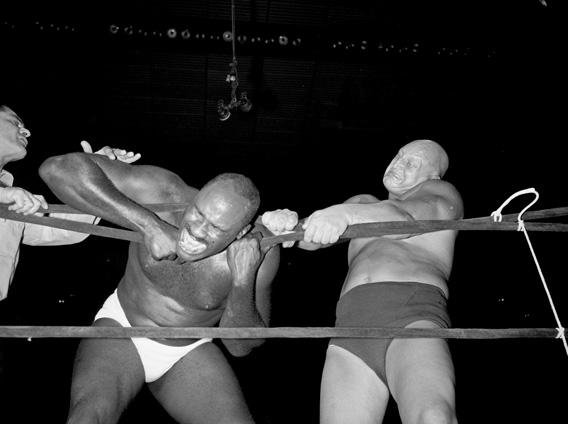 “Villainous Skull” Murphy, early 1950s He became known as “Villainous Skull Murphy,” known for his violence in the ring. He fought the “French Angel,” the “Swedish Angel” and “Gorgeous George.” Village Voice writer Mark Jacobson remembered watching Skull on TV when he was a kid. “Skull was always the bad guy, identified by his special death hold. He’d stomp on a guy’s head when he was unconscious, throw chairs at old ladies who booed him, and rip the microphone from the hands of the announcer. Ed remembered his wrestling career fondly, including Gorgeous George. “The guy was straight, with this fuckin’ peroxided hair and perfume that stunk from here to Canarsie.”
Wrestling money wasn’t enough, so Murphy teamed up with a gay friend to rob dentists, targeting them for shipments of gold from dental laboratories. After 73 dental office robberies, they were caught. Syndicated newspaper columnist Walter Winchell somehow got wind that the culprits were gay. He ran an item in his column that “two swishes with blond hair, whoops, are the notorious Toothache Bandits.” Ed found out who fixed Winchell’s teeth and stole Walter Winchell’s plates. Ed’s favorite Toothache Bandit story concerns a Brooklyn dentist. When Ed and his partner held up the dentist, the man had tears in his eyes. “Don’t take my diamond ring,” he pleaded, “my father gave it to me for my Bar Mitzvah.” Ed let the dentist keep the ring and left with a bag full of gold teeth. Later that night he saw a headline in the Daily Mirror: DENTIST CONS ROBBERS OUT OF RING. He returned to the dentist’s office the next day, beat him up, and took the ring.
In 1947, Ed was sentenced to ten years in state prison. Life was rough in prison. He wasn’t raped. “I knocked down any bastard who tried to touch me. But I spent plenty of time in isolation. The warden didn’t like gay people. Neither did the other inmates. If you bothered with a fag, you were considered pussy yourself.”
When he was released, he worked as a doorman/bouncer in a string of Mafia-owned gay bars including the Cork Club, Bali, Mais Oui, Sans Souci, the 415, the Terrace and Artie’s. “They worked it then that there were three cash registers in the bar,” said Murphy. “Whatever the middle cash register rang up was reported to the government. Some of these spots, like the Pink Elephant, were connected with the Jewish mob. A big owner then was an old politician from Abe Beame’s club. But this was back in the days of Mayor Wagner. Everyone was crooked then…And the cops had their own bag men. You’d pay them $500 a week to keep your joint open.”
At the bars, Ed was “Mother” Murphy to the young male runaways and prostitutes he cared for and sometimes pimped out for tips. Ever the one to moonlight for more money, in the early 1960s Ed Murphy was hired as a house detective at the New York Hilton doing discreet security work. It was in this role that he became an active participant in the infamous “Chickens and Bulls” extortion ring.
Coming Tomorrow: Chapter 3: The Chickens and the Bulls
Chapter 1 – Meeting Ed Murphy
The story of Ed Murphy is fascinating, the way scandal, secrets, and evil are fascinating. It is a story with all the best ingredients—lust, betrayal, corruption, powerful men, redemption, and most of all—irony.
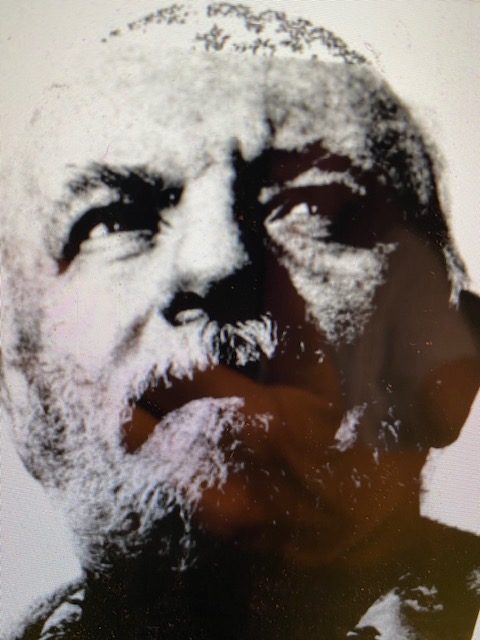 Ed Murphy, 1978 Ed “Skull” Murphy, a gay man who preyed on other gay men, was a secret informer for the FBI. He was protected by the FBI in return for the information he provided on Mafia operations and corruption in New York. He was also rumored to have photos of FBI director J. Edgar Hoover and other prominent government, business and entertainment figures having sex with male prostitutes. Ed Murphy ran prostitution rings of teenage boys and worked as a bouncer in gay bars. He was the doorman at the Stonewall bar the night of the famous raid on June 28, 1969. At that time, he did not identify himself as a gay man. He “came out” a decade later, at the end of the 1970s, when he said that he wanted to quit working for Mafia associates and stop informing for the police and FBI.
Ed reinvented himself as one of the heroes of the Stonewall raid. He continued to work in gay bars. He cultivated a tremendous visibility as the head of the Christopher Street Festival Committee, which organized the vendor booths/party/rally at the end of the annual Gay Pride Parade serving hundreds of thousands of people. Ed Murphy rode in a vintage Cadillac convertible near the head of the parade reserved for those who had been at Stonewall the night of the raid and riots on June 28, 1969. This date is now generally accepted as the beginning of the modern gay and lesbian rights movement.
I met Ed Murphy in the early 1980s when he was working in some bar in the Village, either Stonewall or One Potato, Two Potato. Ed was built like a brick house, stocky and solid, with a body that must have been all muscle in his youth. I was organizing the first group of Conference for Catholic Lesbians (CCL) marchers in New York’s Gay Pride Day parade. We also wanted to have a booth at the Christopher Street Festival in the Village for marchers to hang out after the parade. A booth on Christopher Street would also give us a great opportunity to hand out literature and meet and connect with other lesbians who had been raised Catholic. When I met him, Ed Murphy, or “Mr. Murphy” as I used to call him, was a leader in Heritage of Pride, the organization that ran the parade, festival, and dance in New York City. As such, he was the person to talk to about getting space. Ed always gave CCL table space right in front of St. Veronica’s Church.
“My sister is a nun,” he said to me. “Make sure you take good care of these girls,” he told the guy responsible for assigning spaces.
Our prime location paved the way for many women to find CCL. Ed Murphy always came by our table to make sure that we were fine, and everything was OK. That was my key impression of him: we were small and not influential on the gay scene, but Ed Murphy took care of us. That was also the impression of my friend and CCL co-worker, Barbara M. when she took over organizing the Pride Day booth.
“I remember the last time I had seen him; I was down on Christopher Street and found someone else setting up a booth in our space. I found out that Ed was sitting in a nearby bar, and I went in and found him without any trouble. He seemed to have a lot of adoring fans around him. I told him the story, and he sent out a couple of guys to straighten things out…I thought that they realized Ed was the authority, which prompted them to move, but they may have been afraid of him for all I know…I’d met Ed only three or four times and had short, congenial conversations with him. He was also middle aged by the time I met him. I found him very pleasant. I remember my last conversation with him was his concern that too many of the young fellas were still going bareback, and this was at the height of the AIDS crisis. He said much of the same sort of things I would say today: these kids think they’re immortal; you can’t make them see the seriousness of it because they don’t think it will happen to them. I was never sure if his calling me “Sister” had to do with the fact that I look like a nun or ex-nun…” said Barbara M.
When I met Ed Murphy, I was in my early 30s and he was about the same age as my father. They shared a similar upbringing and formation – the Great Depression and World War II. As boys they were poor, fast with their fists, and nonchalant about thievery. They grew up with no money – they stole to enjoy things their families could never buy. As men they could be gallant or menacing; fiercely protective or brutal. Ed referred to the police by the same name that my father did, “The Bulls.” Big guys with nightsticks that had no hesitancy about using them.
Ed spoke one night to a small group of lesbian and gay Catholics where we met on the Upper West Side in Manhattan. I was very moved to hear the story of his life and description of gay life in New York pre-Stonewall. Ed served time in jail. He stabbed another inmate in self-defense. Ed also made a point to say that he was proud that he didn’t rat people out to “the Bulls.” I had tears in my eyes at the end of his talk. He went through a lot of hell to help bring us to a place where we could live and love more freely. My last memory of him that night was seeing him standing under a streetlight saying goodbye. He looked like an old ex-fighter, scarred, and beaten up, but never a quitter.
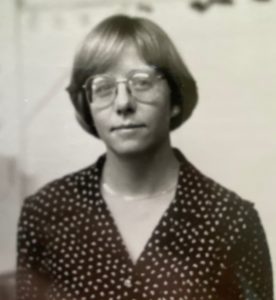 Karen Doherty, 1986 Imagine my shock when, 15 years later, I opened my Wall Street Journal to read an article by William McGowan, “Before Stonewall” which described a vicious extortion ring which targeted prominent and affluent closeted gay men. The gang was finally exposed and put out of business in 1966, but it ran for several years and netted over two million dollars. One of the major figures in this case was Edward “Mother” Murphy, a “ruthless West Side tough” who worked with a dozen other criminals in New York, Chicago, Washington, DC, Los Angeles, San Francisco, and a few other cities to blackmail men who picked up a male prostitute for sex during an out-town trip or when their family was away. “The Chickens and the Bulls,” as the case was known to the New York Police Department and District Attorney’s office, centered on “fairy shaking” or exposing men for their “homosexual proclivities” unless they paid well for it to be kept quiet. Over 1,000 men were victimized by the ring, including the head of the American Medical Association, two Army generals, a Navy admiral, several Hollywood celebrities, college professors and trustees and businessmen.
I relayed my discovery to my friend, Barbara M., who also met Ed Murphy, to hear her reaction. She said,
“To be frank, I’m having a tough time connecting the Ed Murphy I met with the “West Side tough” that he’s described as, or someone who would blackmail fellow gays,” she wrote. “This was in ’65. Ed Murphy was head of security in the Hilton Hotel, and when cornered he cooperated, which is probably why he got the light sentence. Although I think the basic person remains even as the body ages, men mellow. My theory is that the decreased testosterone is a good thing for some of them. Ed may have mellowed a lot and had a metanoia. He struck me as opinioned and forthright, but he didn’t act like a hoodlum. Nonetheless, he might have been. I was just a mere acquaintance; you knew him better. Can you picture that he was involved in this stuff? Maybe prison changed him. His sentence was rather light, and he didn’t serve the entire five years. Maybe he was an informant.”
Many years later, I am still trying to sort out my feelings about Ed Murphy. I knew him as a notable figure in the New York gay community in the 1980s. He was a kind, protective man to the less visible in the city–street kids, drag queens, and mentally challenged children. Ed was generous and caring to all those that he took under his wing, including my group of Catholic lesbians. I am appalled by the image of him as a leader and collaborator in a gay extortion ring, bullying sex and money from vulnerable men and teenagers. Ed Murphy combined prostitution, blackmail and strong-arm tactics into lucrative enterprises that ran for years.
He was also an informer, the worse type of person to anyone of Irish descent. It took the combination of a battery of Irish Catholic New York City Police detectives, the FBI, New York District Attorney Frank S. Hogan, and a federal prosecutor, Andrew J. Maloney, to finally knock him down. But it took the Stonewall raid, a beating by NYC police and a prison rape before he finally had enough and came out as a gay man and activist. That he ended up the Grand Marshall of the New York City Gay Pride Parade 23 years after his conviction for homosexual extortion is a story that boggles the imagination. Catholicism features stories of saints whose lives were full of depravity and evil but ended up redeemed through acts of virtue and heroism. Maybe that is Ed Murphy’s story, or maybe it is just the story he told himself and others.
Chapter 2: “Villainous Skull Murphy” will be posted tomorrow. You can read the whole article Ed_Murphy_Gay_Blackmailer_and_Activitist
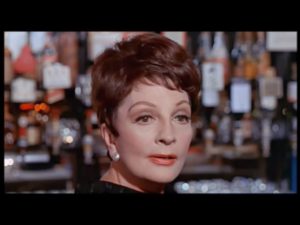 Coral Browne (July 23, 1913-May 29, 1991) was an accomplished stage and screen actress. She was also actor Vincent Price’s third wife. She was a woman who enjoyed a varied and robust sexual life. Browne portrayed no-nonsense BBC-executive, Mercy Croft, in The Killing of Sister George, a film depicting a lesbian love-triangle. She is perfect as a smooth, predatory seductress—a role in which she had plenty of experience. Coral Browne (July 23, 1913-May 29, 1991) was an accomplished stage and screen actress. She was also actor Vincent Price’s third wife. She was a woman who enjoyed a varied and robust sexual life. Browne portrayed no-nonsense BBC-executive, Mercy Croft, in The Killing of Sister George, a film depicting a lesbian love-triangle. She is perfect as a smooth, predatory seductress—a role in which she had plenty of experience.
Coral Browne converted to Catholicism shortly after World War II and remained a devout Catholic throughout her life. As a gift to her, Vincent Price converted to Catholicism. Her friend, Noel Davis, described the melding of her personality and faith: “I’m a Catholic of a sort, and I was always amused by her Catholicism because she was much more devout than fitted in with her obscenities. She never missed Mass on Sunday.” Existing the Brompton Oratory one Sunday morning, salty-tongued Browne was accosted by a theater friend with the latest gossip. She stopped him midsentence, exclaiming: “I don’t want to hear such filth, not with me standing here in a state of fucking grace.”
Browne did not get along with Vincent Price’s daughter, Victoria Price, but they both shared an interest in women. “Coral lent a sympathetic ear to my romantic troubles. Both were eager to meet anyone I brought home, though my stepmother rarely missed an opportunity to flirt outrageously with my girlfriends or to comment on their looks and style. One woman, she told me with a very knowing smile, “does it very well.” I took that as some kind of compliment.” Coral also told Victoria Price about a five-year relationship she had with a woman. Its dissolution was, according to Browne, the most heart-breaking moment of her life. 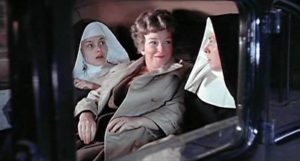
In The Killing of Sister George (1968), BBC executive Mercy Croft (Coral Browne) is sent to chastise Sister George/June Buckridge (Beryl Reid) for a drunken incident involving two nuns. Buckridge is a middle-aged soap opera actress, and Alice “Childie” McNaught (Susannah York), her lover, has a minor fashion industry job, writes poetry and collects dolls. George/June is often verbally and physically abusive to Alice, and her treatment of her becomes worse as her character is scheduled to be eliminated on the popular show. The movie was given an “X” rating because of a two-minute masturbation scene between Coral Browne (Mercy Croft) and Susannah York (Alice “Childie” McNaught). The scene was panned as cold and unsexy—probably because they had most of their clothes on and didn’t writhe and moan continuously. But in 1968 it was revolutionary to see two mature women–McNaught was in her 30s and Croft was in her 50s–having sex to orgasm in a movie.
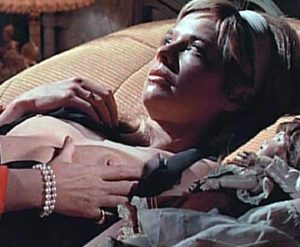
The movie was also history-making in that the director used a real lesbian bar for the lesbian club scene. Between June 9-16, 1968, The Killing of Sister George was shot at the Gateways, a lesbian club that operated in London between 1931 and 1985. Forty members were used as extras, one of whom lost her job when her employer recognized her in a publicity still. George and Alice go to an event at Gateways to which George jokingly invites Mrs. Croft. Mrs. Croft arrives to tell June in person that Sister George will die by being hit by a ten-ton lorry, eliminating her from the show. After June storms out, Mrs. Croft invites Alice to meet with her to further discuss her poetry. Alice has found a new lover/provider and June blew her chance with a woman she once desired and adored.
I wonder how Coral Browne reconciled the sexual and religious aspects of her life. She doesn’t strike me as a hypocrite and didn’t feel obligated to “leave” the Church. Browne died in 1991 without expressing a public opinion or statement; so we’ll never know her thoughts and feelings. The one aspect we do know is that she appeared to value monogamy while married. She had Vincent Price give up a male friend to whom he was strongly attached. That hurt Price deeply. It’s my one mark against Coral Browne.
How do you remain as lesbian and Catholic? My stance—perhaps Coral Browne’s—is to embrace the beautiful and positive in both and dismiss the negativity from secular skeptics and religious gatekeepers. The focus on what is most important – our relationship with God – can be difficult to achieve with all the worldly chatter and distractions; but over time we can sustain it through prayer, quiet time, meditation and the Eucharist.
Click here to see a trailer of The Killing of Sister George.
Click here to see a YouTube video of the Gateways club scene in the film.
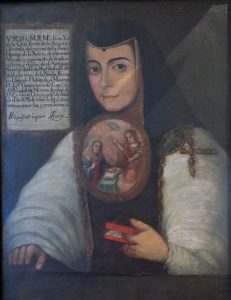
Sor Juana Ines de la Cruz (November 12, 1648 – April 17, 1695), was passionate about educational access, books, learning, equality and women. She was a 17th century nun, self-taught scholar and acclaimed writer. She was born in San Miguel Nepantla near Mexico City on November 12, 1648. Her parents were Isabel Ramirez, a Criolla (native-born Spanish) woman, and Captain Pedro Manuel de Asbaje of Spain. They didn’t marry. Juana lived a comfortable life on the estate of her maternal grandfather. She educated herself in her grandfather’s library. Juana was a high-spirited girl who loved learning and the life of the mind. She was also very beautiful to which her portraits will attest. She was fluent in Spanish, Nahuatl and Latin.
When she was 16 she asked for her parents’ permission to disguise herself as a youth to attend the university, which did not accept women. Her family sent her to court to meet influential people and find a husband. Instead, in 1669, she entered the monastery of the Hieronymite nuns. She choose to become a nun “to have no fixed occupation which might curtail my freedom to study.”
As a nun, she was free to study the 4,000 books she collected, mostly from her grandfather’s library. Her cell became a salon for the intellectual elite. She gained the patronage of the viceroy, Marquis de la Laguna, and the vicereine of New Spain, Countess Maria Luisa de Paredes. They supported and protected her, and had her works published in Spain. The two women became passionate friends. Whether or not a physical relationship existed isn’t clear, but love and desire definitely existed. In her poem, “My Lady” Sor Juana Inez describes her emotions: 
“I love you with so much passion, neither rudeness nor neglect can explain why I tied my tongue, yet left my heart unchecked.
The matter for me was simple; love for you was so strong, I could see you in my soul and talk to you all day long.
How unwisely my ardent love, which your glorious sun inflamed, sought to feed upon your brightness, though the risk of your fire was plain!
Let my love be ever doomed if guilty in its intent, for loving you is a crime of which I will never repent.”
Sor Juana’s sermons, which were transcribed and widely circulated, paid unusual attention to gender imagery. She said that she had been conceived as a male but was changed in utero by God to become female. She delighted in Jesus’ self-reference as a mother hen and spoke of the male and female aspects of God. She believed this mixture of identities also resided in the human soul:
“And all those who seek in me a father,” she wrote, “will find me a father. And those who seek in me a mother, will find in me a mother. And those who seek in me a husband, will find in me a husband. And those who seek in me a bride, will find a bride. And those who seek in me a brother, or a friend, or a neighbor, or a companion, likewise will find in me everything they desire.”
In 1692, Church authorities cracked down on Sr. Juana, not because of gossip or lesbian love poetry, but because she openly challenged societal and ecclesiastical values and norms on women. In her most famous work “Respuesta a Sor Filotea” she defends women’s rights to educational access and opportunity to serve as intellectual authorities. Sor Juana argued that women could educate other women.
Threatened by the Inquisition, Sor Juana was silenced for the final three years of her life. There are documents showing her agreeing to undergo penance. One such document is signed, “Yo, la Peor de Todas” (I, the Worst of all Women”). Her books, scientific and musical instruments were confiscated and sold. Sor Juana died three years later nursing her sister nuns during a cholera epidemic. She was 46. Sor Juana is buried in the site of her former convent, San Jeronimo, at the University of the Cloister of Sor Juana in Mexico City.
Sor Juana lay in oblivion for several hundred years until Phoenix-like she sprang into life. Two of the sparks were books and research done by writers Octavio Paz of Mexico and Dorothy Schons of the University of Texas. 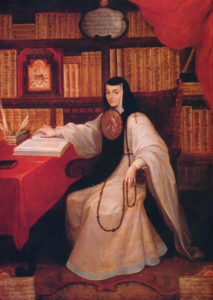
The relationship between Sor Juana and Countess Maria Luisa is explored in “Sor Juana’s Second Dream” a book published in 1999 by Dr. Alicia Gaspar de Alba. She also writes about Sor Juana in “(Un)framing the Bad Woman: Sor Juana, Malinche, Coyolxauqui and Other Rebels with a Cause,” published in 2014. A series of photos inspired by Sor Juana’s life and passions was created by Alma Lopez in 2019. Gaspar de Alba and Lopez, married to each other since 2008, have also explored lesbian connections with Our Lady of Guadalupe.
Maria Luisa Bemberg, one of Latin America’s foremost female directors, imagines the love between Juana and Maria Luisa in the 1990 film, “I, the Worst of All.” The film was Argentina’s entry for Best Foreign Language Film that year.
How far did the passions of Sor Juana go? My feeling is that she had an unbridled imagination, a tormented yearning and a chaste life. I’m sure she shared some tender, passionate, embraces with Maria Luisa, but a lack of time, privacy and mutual restraint kept a lid on any other expressions. But what a kiss it must have been!
 Mosaic at the entrance to St. Michael’s Church In Neil Simon’s 1976 comedy mystery film, Murder by Death, the character Sam Diamond, a parody of the fictional detective, Sam Spade, is played by Peter Falk. His secretary (and girlfriend) blows his cover as a straight, tough guy when she tells the other detectives and guests that Diamond keeps stacks of naked muscle man magazines in his office. Diamond counters that they are part of his detective work –“I’m always looking for suspects!” he says. “I hate them queeries!”
The Rev. George William Rutler, 75, hates queeries, too, but must he have needed new material for an article, Eternal World Television Network (EWTN) program, or one of his pounding homilies. On November 4, 2020, he was caught watching gay porn on the rectory TV by Ashley Gonzalez, 22, a security guard, who filmed a 19-second clip of a man who looks like Father Rutler watching two men blow each other. Gonzalez said she started filming after she heard “sexual noises” on the TV and saw the priest masturbating. Rutler had initially watched election coverage but switched it off around 1:30 am to something more edifying. I think at that point, Joe Biden had beaten Donald Trump for the presidency.
Rev. George William Rutler is one of the most famous conservative priests in the U.S., and a long-time critic of Pope Francis, Democratic politicians and “sodomites.” According to Rod Dreher of the American Conservative, Rutler “presents himself as a flinty arch-conversative who suffers no fools gladly.” He is quite explicit on his view of sex: “The only safe sex is real sex, done for the procreation of life and the sanctification of love.” 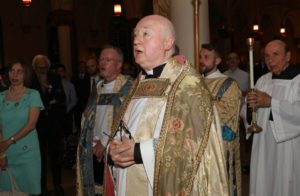
When Gonzalez tried to flee the room, Fr. Rutler grabbed her. “He aggressively threw himself on me and grabbed me sexually, aggressively, and I was fighting him off of me,” Gonzalez told News 12, who added that she sent frantic text messages to her mother begging for help. Gonzalez, who is about five feet tall, got out of the office by elbowing the old geezer in the chest. She made it to the street and called a private detective.
There are a number of weird things in Gonzalez’ story: why would a man who is getting off on two guys having sex try to grope or force himself on a woman? And, how can you possibly have time or your hands free to text your mother if someone is trying to rape or molest you?

What seems unequivocal thanks to a cell phone video clip is that Rev. Rutler’s career as a conservative Catholic spokesman and as a liberal and gay basher is washed up. Even though the assault accusation could be a “he said, she said” situation, the video evidence, and the downloads and browser history on the rectory computer will not lie. Rutler has stepped down as pastor of the Church of Saint Michael Church in Manhattan and has been dropped by EWTN.
One of Fr. Rutler’s quotes on homosexual activity sums up his downfall perfectly: “If people want to engage in aberrant sexual activities, well, by all means then they are free to do so. They are free to pay the penalty.”
P.S. To the Episcopal Church: STOP sending us your self-loathing, hypocritical homosexual priests! We have enough of our own.
“Then Stephen took Angela into her arms and she kissed her full on the lips.” That sentence has thrilled tens of thousands of lesbian readers, including me, to finally see, feel, imagine their desire in print. When British novelist Radclyffe Hall (1880-1943) published The Well of Loneliness in 1928, it was the first widely read novel to feature lesbian love. A British court judged the book obscene because of the words “and that night they were not divided.” 
It tells the story of Stephen Gordon, a woman given a man’s name by parents that wanted a boy, who is irresistibly drawn to other women. She was born on Christmas Eve and named after the first Christian martyr. As a girl she had a dream: “that in some queer way she was Jesus.” Seven-year-old Stephen develops a crush on the Gordon’s maid, Collins. When she discovers that Collins has “housemaid’s knee” she prays that the affliction be transferred to her. “I would like to wash Collins in my blood, Lord Jesus—I would very much like to be a Saviour to Collins—I love her, and I want to be hurt like You were.” Stephen is later devastated when she catches Collins sharing a kiss with the footman.
As a young woman Gordon has an affair when a neighbor’s wife. After a confrontation with her mother about her “unnatural” love, she retreats to her father’s study and discovers a book by German psychiatrist, Krafft-Ebing, on deviant sexuality. After she reads it, she understands what she is—a female “invert,” a lesbian. She opens a Bible, and seeking a sign, reads Genesis 4:15: “And the Lord set a mark upon Cain…” Radclyffe Hall used the mark of Cain, a sign of crime and exile, throughout the book for the status of “inverts.”
Stephen meets Mary Llewellyn, the love of her life, in France during World War I. The two set out to build a life together, but Stephen believes that Mary’s life is suffering because as a couple they are an object of scorn and contempt. To “save” her, she feigns an affair with another woman to drive Mary into the arms of a man who admires and wants her. Mary leaves her and marries. Stephen is devastated and alone. She has a vision of being thronged by millions of inverts from throughout time, living, dead and unborn. They beg her to speak with God for them. Possessing her, she articulates their collective prayer: “God,” she grasped. “We believe, we have told You we believe…We have not denied You, then rise up and defend us. Acknowledge us, oh God, before the whole world. Give us also the right to our existence!”
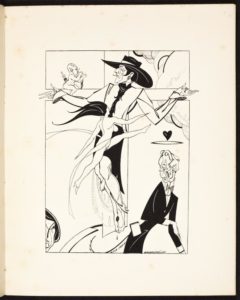
Radclyffe Hall was a pioneer in her efforts to reconcile Christianity and homosexuality. Her defense of gay men and lesbians took the form of a religious argument: if God created inverts, the rest of humanity should accept them. Declaring homosexuality to be a “part of nature, in harmony with it, rather than against it.” She posed the question to her attackers: “if it occurs in and is a part of nature, how can it be unnatural?” She also knew the price that gay and lesbian people pay to remain in the closet and railed against the “conspiracy of silence” saying, “Nothing is so spiritually degrading or so undermining of one’s morale as living a lie.” 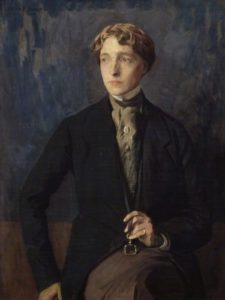
The controversy over The Well of Loneliness was lampooned in The Sink of Solitude, a satirical pamphlet by Beresford Egan, novelist, and illustrator. One drawing shows an immediately recognizable Radclyffe Hall with her trademark Spanish riding hat nailed to a cross. A near-nude Sappho leaps in front of the martyred “St. Stephen” and Cupid perches on the crossbeam. While Egan agreed with Hall’s arguments, he spoofed her piety and moralizing.
Radclyffe Hall is like many Catholic lesbians I have met: conventional, judgmental, spiritual, and often promiscuous.
She was born Marguerite Radclyffe on August 12, 1880 at Christchurch, Bournemouth, England. In later life she was called John by her friends and lovers, and M. Radclyffe Hall or Radclyffe Hall in her books. Her mother, Marie, was an American and her father, Radclyffe Radclyffe Hall, was English. Her parents divorced when she was two and Marie remarried a musician, Albert Visetti. The young girl never liked him. She reached young womanhood without much education or interests except chasing women. Her specialty seems to be the seduction of married women.
In 1907, at 27, unattached and drifting, Hall made a trip to Bad Homburg, Germany, known for its wellness spas and baths. She became smitten with Mabel (Ladye) Batten, a renowned beauty and amateur singer. Batten’s portraits were painted by John Singer Sargent and Edward John Poynter. The 50-year-old married grandmother had ties to aristocratic society and was rumored to have had an affair with King Edward VII. The poet-adventurer Wilfrid Scawen Blunt was an admirer. Witty, elegant, cultured, beautiful and worldly, Batten was everything Hall desired. They became lovers and stayed together until Batten’s death in 1915. 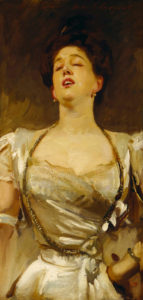
Batten was a major influence on Hall, and encouraged her to write poetry. Hall’s first book of poems, A Sheaf of Verses, published in 1908, reveals her first, tentative references to homosexuality. A second book of poetry including the “Ode to Sapho” was published later that year. Her third volume came out a year later. When Batten’s husband died in 1910, the two women made a home together. Hall’s fourth poetry anthology was dedicated to Batten.
Batten was politically conservative, and Hall adopted her positions. Ladye was also a Catholic convert, and under her encouragement and influence, Radclyffe Hall was received into the Catholic church on February 5, 1912. She was 32. Her baptismal name was Antonia, and she chose Anthony as her patron saint. Hall and Batten worshiped together at London’s fashionable Church of the Immaculate Heart of Mary, known as the Brompton Oratory. In 1913, Hall and Batten made a pilgrimage to the Vatican. They went to Mass at St. Peter’s Basilica. Pope Pius X blessed them in a semi-private audience with other substantial donors. They returned to London with religious-themed triptychs, gilt angels and an alabaster Madonna.
The refined Ladye was both a maternal and wifely figure for Radclyffe Hall. The once-feminine Hall, who wore skirts all her life and only had her waist length blond hair cut in her 30s, started to cultivate a more masculine appearance, close-cropped hair, tailored jackets and bow-ties. Batten gave Hall the nickname “John” after noting her resemblance to one of Hall’s male ancestors. She used this name for the rest of her life. Was Hall butchy, a butch, stone butch, or these days – a transman? It’s hard to say. She said that she had a man’s soul in her body.
In 1915, 35-year-old Radclyffe Hall met Una Troubridge (1887-1963), a 28-year-old cousin of Mabel Batten, at a tea party in London. They were immediately sexually attracted to one another and began an affair. Their relationship that would last until Hall’s death in 1943. Troubridge was a sculptor and mother of a young daughter. She was married to Vice-Admiral Ernest Troubridge, a career naval officer who was 25 years her senior. Hall’s affair with Troubridge caused an uneasy situation among the three women. 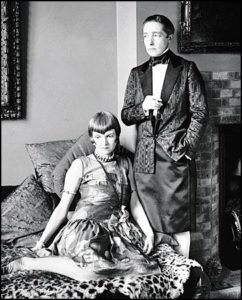
In May 1916, Batten suffered a cerebral hemorrhage after a quarrel with Hall over Troubridge. She died ten days later. Guilty and grief-stricken, Hall believed her infidelity had hastened Batten’s end. She had Batten’s body embalmed and buried her with a silver crucifix blessed by Pope Pius X. Soon after Batten’s death, Hall and Troubridge developed an interest in spiritualism and began attending seances with a medium, Mrs. Gladys Osborne Leonard. They believed Batten’s spirit gave them advice.
Most of the stories, poems and novels Radclyffe Hall wrote touched on Christian themes, Catholic imagery, lesbian desire or all three. In 1924, Radclyffe published The Forge, a fictionalized portrait of American lesbian artist Romaine Brooks, and The Unlit Lamp, a novel about a girl who dreams of going to college and setting up a “Boston marriage” with her tutor, Elizabeth. A Saturday Life (1925) follows the life of a girl who takes up and discards many artistic pursuits with the support of an older woman who is in love with the girl’s mother. Hall’s fourth novel, Adam’s Breed (1926) centered on the spiritual struggles of a young man over excess consumption by modern society. He becomes disgusted with his job as a waiter and even with food itself, gives away his belongings and lives as a hermit in the forest. The story also reflect’s Hall’s concern about the plight of animals. The book won the 1926 James Tait Black Memorial Prize for fiction and the Femina Vie Heureuse Prize for best English novel.
In early July 1926 Hall completed the short story, “Miss Ogilvy Finds Herself,” which dealt with homosexuality. Later than month she began writing Stephen, the novel that became The Well of Loneliness (1928). The Master of the House (1932) is an adaptation of the Christ story in a contemporary setting. Christophe Benedict, the main character, is a deeply spiritual and compassionate carpenter who lives in Provence, France. He is born to a carpenter named Jouse and his wife, Marie. Christophe ends up being crucified by Turks in Palestine during World War I. Writing the book was so spiritually intense that Hall developed stigmata on the palms of her hands.
In the 1930s Hall and Troubridge made their home in Rye, a village in East Sussex where many writers lived. Hall used Rye as the setting for the book, The Sixth Beatitude (1936), her last novel. It is the story of Hannah Bullen, a strong-bodied young woman. Hannah Bullen’s unconventional life (unmarried mother of two children) is beset by poverty and strife within her family. Hall uses the sixth Beatitude to portray Bullen’s purity of heart and mind by sticking with them. An independently wealthy heiress, Hall gave generously to the local church. Saint Anthony of Padua was constructing a new building when they moved to Rye. Biographer Diana Souhami wrote that Hall “poured money into the church” to bring it to completion and furnish it. “She paid for its roof, pews, outstanding debts, paintings of the Stations of the Cross and a rood screen of Christ the King. A tribute to Ladye was engraved on a brass plaque set into the floor: “Of your charity, Pray for the soul of Mabel Veronica Batten, In memory of whom this rood was given.” 
What is the attraction of lesbian and gay men to Catholicism? Why did so many late 19th century writers, intellectuals, artists, clergy and bohemians (with gay lovers, tendencies or friends) take the plunge into the faith? Notable converts include Oscar Wilde, Gerard Manley Hopkins, Aubrey Beardsley, lovers Katherine Bradley and Edith Cooper, Ronald Firbank, Maurice Baring, Eric Gill, Robert Hugh Benson, John Henry Newman, Frederick Rolfe, Marc-Andre Raffalovich, John Gray; and, of course, Mabel Batten, Radclyffe Hall and Una Troubridge.
Oscar Wilde opined on the attraction of the Roman Catholic Church for outre artistic figures and rebels. He said that Catholicism was “for saints and sinners,” while…” for respectable people, the Anglican Church will do.” Becoming Catholic was an act that allowed one to become both rebellious and steeped in tradition. Irish playwright and novelist Emma Donoghue observed: “Being Catholic in England meant becoming slightly foreign, aloof from the establishment; as a church it was associated with the rich and the poor, but definitely not the bourgeoisie.” For much of English society, to become Catholic was to cross society’s lines to a suspect, “other,” even deviant, religion. But the “otherness” may have been a reason behind its attractiveness.
The sensuousness and eroticism present in Catholic art and ritual have a magnetic appeal to lesbian and gay people. Beautiful men, barely covered; women with their heads thrown back in orgasmic passion—a feast for the eyes and imagination. We can appreciate symbolic and hidden meanings, the emphasis on the body, particularly the Eucharist, where we take the body of Christ into our mouth; and the mystery inherent in ourselves and in the spiritual world. 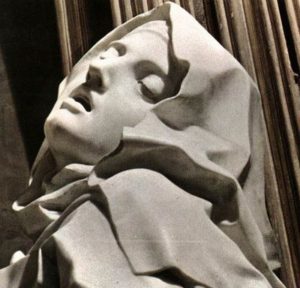
Modern scholars have explored the role of religion in Radclyffe Hall’s work. Catholic Figures, Queer Narratives (2007) includes the chapter “The Well of Loneliness and the Catholic Rhetoric of Sexual Dissidence” by Richard Dellamora. He explores Hall’s life and work. Ed Madden, English professor at the University of South Carolina, examines Hall’s use of Christ’s imagery and symbolism in Reclaiming the Sacred: The Bible in Gay and Lesbian Culture (2003) edited by Raymond-Jean Frontain.
Like a bee sipping nectar from flower to flower, Hall’s desire for women never waned. Her indiscretions as “man of the house” could be overlooked as long as they were brief. Una Troubridge and Radclyffe Hall stayed together as a couple until Hall’s death in London from colon cancer in 1943. The relationship survived Hall’s numerous flirtations and Hall’s last torrid affair with her 28-year-old White Russian nurse, Evguenia Souline (1906?-1958). Souline was hired to help care for Hall during an illness, and their relationship blossomed into much more. Despite the initial protests of Troubridge, the three women lived together in Florence, Italy. At the outbreak of World War II they left and settled in Devon, England. “Darling—I wonder if you realize how much I am counting on your coming to England,” Hall wrote to Souline, “how much it means to me—it means all the world, and indeed my body shall be all, all yours, as yours will be all, all mine, beloved. And we two will lie close in each others arms, close, close, always trying to lie even closer, and I will kiss your mouth and your eyes and your breasts—I will kiss your body all over—And you shall kiss me back again many times as you kissed me when we were in Paris. And nothing will matter but just we two, we two longing loves at last come together. I wake up in the night & think of these things & then I can’t sleep for my longing, Soulina.” Una Troubridge cannot have been happy reading that note. Even so, much of Hall’s correspondence to Evgenia Souline has been preserved. Troubridge burned Souline’s letters to Hall.
Radclyffe Hall died at her flat in Pimlico on October 7, 1943. She bequeathed her entire estate to Troubridge. At her request, she was buried in a vault next to Mabel Batten in Highgate Cemetery in London. Souline was given a small allowance and disappears from the story. At the time of her death, The Well of Loneliness had been translated into 14 languages and was selling more than 100,000 copies a year. It has never gone out of print. For decades, it was the only lesbian book generally available. 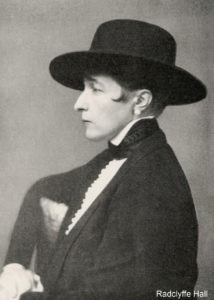
Troubridge, now a wealthy woman, moved to Italy and died of cancer in Rome in September 1963, at age 76. Shortly before Troubridge died, a woman asked her how she and Hall reconciled their relationship with their Catholic faith. What did they do about confession? Troubridge answered, “There was nothing to confess.” Troubridge left written instructions that her coffin be placed in the vault in Highgate Cemetery where Hall and Batten had been buried, but the instructions were discovered too late. She was buried in the English Cemetery in Rome, and on her coffin was inscribed, “Una Vincenzo Troubridge, the friend of Radclyffe Hall.” Years later her tomb was removed and her remains were lost.
The Well of Loneliness has been criticized by lesbians for its stereotypical butch-femme coupling, energetic lesbians who are always masculine looking, and requisite unhappy ending of a love affair or relationship between two women. What is totally ignored is Hall’s Christianity and Catholic faith in her life and writing. A friend once observed to me that it is easier to be a lesbian in the Catholic Church than a Catholic in the lesbian community. Like 19th and 20th century biographers who often left out, or slyly alluded to their subject’s homosexual life; too many “herstory” archivists, writers and editors deliberately omit lesbian religious faith and commitment. This bigotry needs to stop.
“Who are you to deny our right to love” – Radclyffe Hall The Well of Loneliness

“Homosexuals have a right to be part of a family,” said Pope Francis. They’re children of God and have a right to a family. Nobody should be thrown out or be made miserable because of it. What we have to create is a civil union law. That way they are legally covered,” he continued. “I stood up for that.”
The pope’s remarks were aired in Francesco, a documentary on the life and ministry of Pope Francis which premiered October 21, 2020 as part of the Rome Film Festival. The film included a story about the pope encouraging two Italian men to raise their children in their parish church. One of the men, Andrea Rubera, said he gave Pope Francis a letter that described conversations he and his partner were having over whether to take their children to church, fearing they might be subject to unfair judgement as children of a gay couple. Rubera said the pope called him and encouraged them to take their children to church and to be honest with the pastor about their living situation.
The pope’s comments rocked the Catholic world. Pope Francis clearly stated gay and lesbian people have a right to civil unions. They also have a right to be part of a family. This stance put him in direct opposition to many U.S. bishops and pastors who believe gay people should be driven away or at least kept in the closet and silenced. The Catholic hierarchy and conservative media will continue to campaign against gay marriage and adoption, but they look over their shoulder doing so…they don’t have the full blessing of “truth” and free rein to hurt and slander. Doing so could really impact their clerical career and prospects while this pope is in charge. 
No red hat for culture warriors that focus on gay marriage and abortion but are silent on poverty, prejudice, and environmental degradation. Pope Francis’ statement has reframed the whole discussion of pastoral ministry to gay and lesbian people. In countries where homosexuality is against the law, it has effectively stifled bishops from speaking out in support of these laws.
Contrast the pope’s attitude on civil unions and those of the two previous popes. In 2003, The Congregation for the Doctrine of the Faith (CDF) declared in Considerations Regarding Proposals to Give Legal Recognition to Unions Between Homosexual Persons: “The Church teaches that respect for homosexual persons cannot lead in any way to approval of homosexual behavior or to the legal recognition of homosexual unions…Legal recognition of homosexual unions or placing them on the same level as marriage would mean not only the approval of deviant behavior, with the consequence of making it a model in present-day society, but would also obscure basic values which belong to the common inheritance of humanity.” The statement was drafted by the future Pope Benedict XVI and approved by Pope John Paul II.
As big a bombshell as this papal turnaround on gay and lesbian rights and relationships is, nothing will ever equal the impact of Pope Francis’ “Who am I to judge?” comment in July 2013.
On a plane on the way home from World Youth Day in Brazil, Pope Francis stood and took questions from reporters. One of them concerned his hand-picked appointment for the Vatican bank, Italian Msgr. Battista Ricca. Msgr. Battista had been selected by the pope to help clean up the Vatican bank; a total cesspool of corruption and mob influence. Almost immediately stories about Msgr. Ricca’s lovers and sexcapades began to appear in Catholic media outlets. In response to a question about his candidate, here is what Pope Francis said: “If someone is gay and he searches for the Lord and has good will, who am I to judge?” Francis told reporters, speaking in Italian but using the English word “gay.
In the 2016 book, The Name of God is Mercy, Pope Francis elaborated on his history-making remarks: “On that occasion I said this: If a person is gay and seeks out the Lord and is willing, who am I to judge that person?” the pope says. “I was paraphrasing by heart the Catechism of the Catholic Church where it says that these people should be treated with delicacy and not be marginalized.”
“I am glad that we are talking about ‘homosexual people’ because before all else comes the individual person, in his wholeness and dignity,” he continues. “And people should not be defined only by their sexual tendencies: let us not forget that God loves all his creatures and we are destined to receive his infinite love.”
“I prefer that homosexuals come to confession, that they stay close to the Lord, and that we pray all together,” says Francis. “You can advise them to pray, show goodwill, show them the way, and accompany them along it.”
Asked whether there is an opposition between truth and mercy, or doctrine and mercy, the pontiff responds: “I will say this: mercy is real; it is the first attribute of God.”
“Theological reflections on doctrine or mercy may then follow, but let us not forget that mercy is doctrine,” says the pope. “Even so, I love saying: mercy is true.”
There was a huge response around the world to the Pope’s remarks on gay people’s right to a legal recognition of their relationships, and also to participate in society as families. Before these statements are scattered and lost, I wanted to compile a sampling of reactions for a permanent record.
Lesbian and Gay Rights Groups
“This is wonderful news for the LGBT community and for their families. What Pope Francis is telling us is that lesbian and gay people are part of families. He’s holding up family values and this is so important. Progress takes time and this is a step in the right direction. I am elated that Pope Francis is making this public statement. He’s speaking from the heart.” Sister Jeannine Gramick, SL, co-founder, New Ways Ministry
“New Ways Ministry gratefully welcomes Pope Francis’ latest support for civil unions for same-gender couples. It is a historic moment when the leader of the Roman Catholic Church, long seen as a persecutor of LGBT people, moves in such a supportive direction for lesbian/gay couples and their families. It signals that the church is continuing to develop more positively its approach to LGBTQ issues.” Francis DeBernardo, executive director, New Ways Ministry
“While pleased with the news reports, we wonder how the Pope’s comments fit with existing Catholic teachings that condemn same-sex relationships as ‘intrinsically evil.’ We hope that Pope Francis will take steps to enshrine support for same-sex couples, LGBTQI individuals, and our families in official Catholic teachings and will work to formally end Catholic teachings that are hurtful to LGBTQI people.” Dignity USA
“Remember, the most important issue there is love. LGBT people hold the blood of the family, so they belong. If you think they are sinners, it’s not your duty to judge the sinners. I think he has given me a reason for not changing my religion or going to any other church. It gives me courage.” Ssenfuka Joanita Warry, Faithful Catholic Souls Uganda
“Pope Francis took a significant step for inclusion and acceptance in the Catholic Church by embracing unions for same-sex couples and affirming that LGBQI Catholics are part of their religious family.” Alphonso David, president, Human Rights Campaign
Political Leaders
“Time will tell, but I believe that Pope Francis’ support for same-sex unions will ultimately have a profound impact on how gays and lesbians are treated around the world. The Pope’s views, heard by over one billion Catholics worldwide, have incredible power.” Samantha Power, former U.S. ambassador to the United Nations
“The church does not prepare dogma or doctrine via documentaries. That happens when the pope sits down behind his desk.” The pope’s comments “follow years of misery and homophobia suffered by LGBTIQ people who, with Catholic people, have turned the tide. The pope has seen that tide. Let him now follow through.” Mary McAleese, former president, Republic of Ireland
Theologians
“The pope’s statement of encouragement for legal civil unions could very well have a great impact in parts of the world where same-sex relationships are criminalized. In predominantly Catholic nations where homophobia is the law, this statement could undercut anti-gay legislation, and perhaps even lead to its repeal. That would be a great good.” Lisa Fullam, professor of Moral Theology, Jesuit School of Theology, Santa Clara University
“Pope Francis once again is showing that the heart of the Church must be welcoming. It is a colossal step for the pontiff to endorse civil unions. In doing so, he shows that he, and in turn, the Church, are looking for ways to be a welcoming place for all LGBT Catholics. All Catholics should applaud this advancement.” Aaron Bianco, professor of theology, University of San Diego (Bianco was forced to resign as a pastoral associate at a parish in San Diego after he faced a barrage of attacks from anti-LGBT news sites.)
“Such informal remarks are to be praised as a timely shift in-line with overwhelming theological evidence and a growing acceptance of the lived reality of same sex love and partnership by a majority of Catholics worldwide. It should be noted however, that these personal comments are in direct contradiction with current Catholic teaching, according to which same-sex orientation is “intrinsically disordered,” and same-sex relationships are always “intrinsically evil.” We urge Pope Francis to kick-start a process to revise official Catholic teaching and practice so that his latest overtures towards acceptance are transformed into concrete change.” The Wijngaards Institute for Catholic Research
“These words from the pope will inflame many on the Catholic right…but they will be a balm to the vast majority of Catholics and, I daresay, pastors. They don’t want to engage in these ugly culture war battles, especially because gay Catholics are not abstractions—they are in their homes, part of their families, and part of their parishes.” David Gibson, director, Center on Religion and Culture, Fordham University
“I see this as a necessary step in the evolution of the church’s thinking on same-sex issues… it’s a sign of hope that the church can change. It can grow. It can evolve. I think it’s also a sign of hope that especially in places where LGBTQ persons are more actively persecuted, this is a sign of hope that that kind of persecution cannot be reconciled with the Christian faith.” Bryan Massingale, professor of Theology, Fordham University
“(It is a big deal) in part because the Holy Father is clearly representing such civil unions as a good and desirable thing, to be actively promoted, rather than a lesser evil. And second because he affirms the rightness of same-sex couples forming a family and being part of the family of the Church. This will evidently create waves in countries where homosexuality is illegal, as well as cause heartache to rigorist Americans who have sought legal exemption from employing same-sex couples who have entered into legal unions.” James Allison, author, and theologian
Writers, Commentators, Bloggers
“The Holy Father has changed the tone, the approach and the conversation around the issue of LGBTQ Catholics. He is not changing doctrine, but he is changing the conversation, and that is a form of teaching.” James Martin, S.J., writer and editor-at-large, America magazine
“Once again, Pope Francis is spreading confusion among the faithful. How many times must this happen before all good Catholics recognize that we have a serious problem in the Church, and its name is Francis? And radical Catholics, who really do want to overturn established dogma, rub their hands gleefully and seize another opportunity.” Phil Lawler, editor, Catholic World News, and commentator, CatholicCulture.org
“Before I make some pointed remarks about Pope Francis’ latest demonstration of inadequacy, let me make one thing perfectly clear…If we are Catholic but have not prayed regularly for Pope Francis, we have no right to complain. Do we think Satan does not specifically target the successor of Peter?… The latest outrage to the Catholic faith, reason and sensibilities is the Pope’ remarks in a new video documentary in which he insists that homosexual persons have the right to a family, and that the important thing is to establish civil union legislation so they are ‘legally covered.’” Jeff Mirus, founder, Trinity Communications, which runs CatholicCulture.org; co-founder, Christendom College
“So instead of getting all upset and hysterical about this, we should take that for what it is. It was a mistake by a man with good intentions but who just got it wrong. He was trying to give expression to his long-standing desire that we reach out to and include those who are marginalized or alienated from the Church or society. It was an unforced error, and it will have to be corrected either by the Holy Father, his press team, or our own bishops. It’s an opportunity for all of them to publicly reaffirm the true teaching of the Church, which would at least bring some good out of the situation.” Ed Mechmann, Director of Public Policy and the Safe Environment Program &blogger, Archdiocese of New York
“This little, very possibly perverted, Church-hating, Christ-hating, Catholic-hating bastard…Next on his plate, I suspect, bestiality, incest, and (you guessed it) coprophagia.” Mundabor’s Blog – “This blog’s aim is to allow true, traditional, unadulterated, strictly orthodox Catholic doctrine.”
“Unfortunately, Homosexuals do not have a right to family life since they forfeit family life by mocking and forsaking family life through their LGBT activity. Nor do they have a moral right to be around others as long as they are infected with these sodomite aspirations…Francis calls homosexuals the “children of God” deceptively implying they are affectionately embraced by God as they are when in fact they are children of the devil doing the works of the devil, for which they would be forever banished if someone didn’t come along in true charity to encourage them onto the right and shining path. Unfortunately, the pope’s Trump-bashing/pro-LGBT statements occur just at a time when it could swing the Catholic vote in America over to pro-LGBT Joe Biden and thus help bring about the downfall of America and consequently the world. The devil indeed is playing chess on the political board so we pray the Francis’ anti-family statements do not influence the vote in America but that Americans remain ever resolved to vote for Donald Trump who is committed to preserving traditional family values. David Martin, The Eponymous Flower blog
Cardinals and Bishops
“The Pope’s Statement clearly contradicts what has been the long-standing teaching…The Church cannot support the acceptance of objectively immoral relationships.” Bishop Thomas Tobin, Diocese of Providence, Rhode Island
“The Holy Father is very aware of the suffering and alienation of homosexual individuals, gay people, who are rejected by family and society. He is also keenly aware of the parents and loved ones who also suffer because a member of their family is bullied or marginalized for being different.” Cardinal Sean O’Malley, Archdiocese of Boston, Massachusetts
“It makes me very happy that a new door is opening in the church for people who still don’t have a place in it because God is going to ask about them. It is very important that we initiate a new stage in the relationship of the Catholic Church with the LGBT family in the world.” Bishop Raul Vera, Diocese of Saltillo, Mexico
The Pope seems to be emphasizing that we are called to find ways of extending a true sense of family to those who find themselves on the margins, so that they might experience the security of belonging and the joy of encountering the life-changing mercy of Jesus Christ.” Archbishop Bernard Hebda, Archdiocese of St. Paul and Minneapolis, Minnesota
“There are in other countries very strong homophobic tendencies even in church leaders. And what I find, even here ourselves, we have some people whose frustration with their own gay identity is leading them to be homophobic in ways. So, the first thing I’d say is that the Pope is clearing the air for a further discussion. After the same sex marriage referendum here in Ireland I talked about the ideas of a reality check. And this again would be an opportunity for people to do a reality check within the church.” Archbishop Diamuid Martin, Archdiocese of Dublin, Ireland
“The Holy Father is calling us as Church, as he has on numerous other occasions, to begin with the human person. Catechesis is important, but no the starting point. Building relationships comes first, then instruction, conversion, and integrating the faith ever more deeply into one’s life. In a real way he is challenging the Church to expand the tent. The Holy Father has from the beginning of his pontificate encouraged the Church to welcome all people as children of God who are deserving of love and respect. Indeed, this is what the Catechism of the Catholic Church teaches. Finally, this is very much in keeping with Pope Francis’ encouragement to be a Church that accompanies one another. Our Holy Father envisions a compassionate Church, one with a maternal heart, willing to overcome insecurity, fear, and a willingness to reject others. Rather, we are called to be a Church that attracts and welcomes others with the love of Christ.” Archbishop Paul Etienne, Archdiocese of Seattle, Washington
Censor Liborum, Nihil Obstat
Very few U.S. bishops issued a statement in response to Pope Francis’ statement. A few were negative, some positive, all were nuanced and guarded. No one wants to make waves within the U.S. Conference of Catholic Bishops (USCCB), since conservative bishops still hold a voting edge. But as more Pope John Paul II and Benedict VI appointees retire or die off—and if Pope Francis can remain pope for another 5-7 years–we can expect a new crop of more pastorally-minded bishops to dominate the USCCB. They will bring a wider review of social justice issues beside abortion, same-sex marriage, and to a much smaller degree, immigration, and the death penalty. As old bishops depart and modern bishops arrive, I expect more of them to add racism, economic problems, and environmental concerns to their own and the USCCB’s agenda. In the meantime, most bishops will do what they have always done: keep their heads down, try not to notice bad behavior, teach in mild ways, tend to their cash flow, and try to benefit from politics without getting too involved. They also need to weigh how it will affect their career prospects if they publicly agitate against lesbian and gay civil unions. 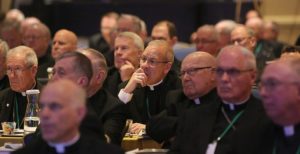
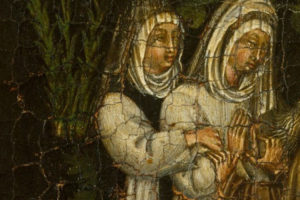
Benedetta Carlini (1590-1661) was a mystic, seductress and nun. Dr. Judith C. Brown chronicled her life in the 1986 book, Immodest Acts. The book came on the heels of Rosemary Curb and Nancy Manahan’s bestseller, Lesbian Nuns: Breaking Silence, which was published in 1985. Benedetta was Abbess of the Convent of the Mother of God in Pescia, Italy when she was accused of heresy and “female sodomy.” Her story is important not only as a documented lesbian relationship in the convent, but how an intelligent, persuasive woman gained, experienced and exercised power and celebrity within Catholicism’ male-dominated structure. In the end, she was brought low by jealousy and her own excesses. She also had miscalculated the tectonic shift in the Church from the Counter Reformation: principally an emphasis on correction of clerical abuses, and more emphasis on intellectual understanding vs. supernatural manifestations of divine favor.
The story of Abbess Benedetta Carlini was discovered by accident by Dr. Brown, a historian at Stanford University while she was researching the economic history of the region and the Medici rule. “I found Benedetta Carlini by chance, by leafing through an inventory of nearly forgotten documents in the State Archive of Florence. The entry in the inventory read: ‘Papers relating to a trial against Sister Benedetta Carlini of Vellano, abbess of the Theatine nuns of Pescia, who pretended to be a mystic, but who was discovered to be a woman of ill repute.’” This discovery of an ecclesiastical investigation contained what is probably the earliest account of a sexual relationship between two nuns. The documents concerning Abbess Benedetta Carlini consisted mostly of transcripts of a series of inquests between 1619 and 1623. 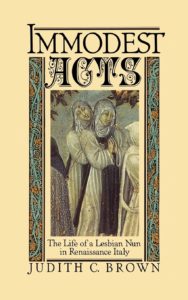
In 1986, Dr. Brown published her book about Benedetta’s life, investigations, and trials. Titled Immodest Acts: The Life of a Lesbian Nun in Renaissance Italy. It was widely reviewed in both scholarly and popular journals and publications. I talked to Dr. Brown about speaking at the Conference for Catholic Lesbians (CCL) West Coast conference in May 1986. Unfortunately, she wasn’t available to participate. Too bad, because many scholars are dry and pedantic, and I found Dr. Brown to be both engaging and knowledgeable. She was one of a handful of women at that time to write an even-handed account of lesbianism who was not a lesbian herself. The book served as a prop in Su Friedrich’s sensational 1987 film, Damned If You Don’t.
Benedetta’s parents brought her to the convent in 1599 when she was nine years old. She entered the Sisters of the Immaculate Conception of the Virgin Mary, more commonly known as the Theatines. The order was founded in 1583 by the Venerable Ursula Benincasa, who was famous for her visions and piety. The fame she gained from her visions led some to accuse her of being possessed by a devil. In 1617, Ursula had her most famous vision, where Jesus (in some versions, Mary) appeared to her. In the vision Jesus praised her order and promised them salvation. Ursula died in 1618 at the age of 71. Benedetta grew up learning about Ursula’s visions and the fame and power that proceeded from them. 
Like the Venerable Ursula, Benedetta had visions. In 1613, when she was 23, she reported visions to the mother superior and her confessor. A young boy helped her climb the “Mountain of Perfection;” she was surrounded by wild animals, only to be saved by Jesus. In another vision, while praying one morning, she found herself “in a garden, surrounded by fruits and flowers.” Male figures came to dominate her visions—a beautiful youth, young men who beat her with sticks, chains, and swords; a handsome guardian angel named Splenditello, and Jesus himself. Over time, the visions increased in intensity and detail, and Benedetta became well known for them. Fearful that Sister Benedetta was being harassed by demonic forces, Sister Bartolomea Crivelli was assigned to share her cell, observe her, and help her if possible.
On the second Friday of Lent 1619, Benedetta received an unmistakable sign of divine favor, the stigmata. Prior to this event Benedetta and others in her community were unsure if her visions were divine or diabolical in origin; but by manifesting the wounds of Christ she proved their divinity.
Her celebrity as a mystic blossomed. That same year the Theatine nuns elected her as their abbess.
Shortly after her election, she began to deliver sermons to the other nuns. She spoke in a trance, an angel speaking through her, exhorting the nuns to purify themselves, and be grateful for Benedetta’s presence in their midst. In the months that followed, there were more trances and visitations: from St. Catherine of Siena and an angel—a beautiful youth in a white robe named Splenditello, even Jesus himself. They spoke from within Benedetta, at times with loving praise, other times harshly or issuing commandments, such as a ban on eating meat, eggs, and dairy products.
On May 20, 1619, Jesus appeared to Benedetta and told her he wanted to marry her in a special ceremony. He had specific ideas for the procession, the chapel decorations, list of guests and the ceremony itself. At the wedding, while the other nuns watched and listened, Benedetta claimed the Blessed Mother looked on benevolently while Jesus placed a gold ring on her finger. Speaking through her, Jesus said, “I would like that this, my bride, be empress of all the nuns.” He added that the Great Duke of Tuscany should be informed of her greatness. All those who did not obey, believe, and cherish her would be punished.
Although the nuns had gone along with Benedetta’s visions, the self-flagellation during trance-sermons and even a ban on salami and cheese; the wedding with Jesus and his dictate that they should obey her or face divine punishment was a step too far. They reported her to the ecclesiastical authorities, who investigated her twice between 1619 and 1623. They discovered that she had faked the stigmata by pricking herself with a needle; secretly ate salami and mortadella during her “ban” on meat and dairy and painted on her miraculous wedding ring with saffron.
But the most damning, was the confession of Sr. Bartolomea Crivelli, Benedetta’s assigned companion. She described her two-year affair with the abbess. The women met for sex at least three times a week. “Embracing her, she would put her under herself and kissing her as if she were a man, she would speak words of love to her. And she would stir so much on top of her that both of them corrupted themselves.” They also masturbated each other and had oral sex to orgasm. Mutual fondling carried a relatively light penalty—two years of penance, plus the loss of Benedetta’s status as abbess. The fact that Benedetta claimed “Splenditello” the angel committed the sexual acts allowed clerical investigators to classify all of Benedetta’s supernatural visions as diabolic in nature. In their report, investigators criticized Benedetta’s “immodest and lascivious language,” and “the great display of vanity” of her mystical marriage with Jesus. 
Benedetta, 36, was condemned to involuntary hermitage and spent the remaining 35 years of her life in solitary confinement. The only other mention of Benedetta is an August 1661 entry in an unnamed nun’s diary stating that Benedetta Carlini died at age 71 of fever and colic pains. The nun added that Benedetta was “always popular among the laity.” For her confession, Sr. Bartolomea Crivelli was spared any punishment. She died in 1660, a year before Benedetta.
Why the long solitary confinement? I suspect jealousy, anger at her duplicity, and fear that her charm and intelligence could help her reclaim a leadership position led some nuns to promote her isolation within the community. She would feel her losses every day. Church authorities wanted to discourage her dangerous popularity with the laity. Her supernatural claims were unwanted in the new age of science and Counter-Reformation.
There is no record of what Benedetta thought and felt after she was led to her lonely cell. Did she have any regrets? Did she revisit her visions– real, imagined or devised? Did her thoughts ever stray to Bartolomea, lying in her bed nearby?
Benedetta Carlini has been the inspiration or subject of films, plays and articles. They include:
Immodest Acts: The Life of a Lesbian Nun in Renaissance Italy by Judith Brown, Oxford University Press, 1986
Damned If You Don’t – a film by Su Friedrich in 1989. If you want to see the film, below are the links for streaming and for DVD
 Damned If You Don’t Vimeo streaming for $3.99
DVD for $24.99
Discourses of Desire: Sexuality and Christian Women’s Visionary Narratives,” by E. Ann Matter, Journal of Homosexuality, 1989-1990
Big Gay Portal to Hell, a podcast by Catherine Clune-Taylor on Caveat
Stigmata, a 2011 play by Carolyn Gage
Vile Affections: Based on the True Story of Benedetta Carlini, a 2006 play by Vanda
Benedetta Carlini: Lesbian Nun of Renaissance Italy, a play by director and playwright, Rosemary Rowe.
Benedetta, an upcoming film directed by Paul Verhoeven and starring Virginia Efira as Benedetta. The film is scheduled to premiere at the 2021 Cannes Film Festival.
|


































